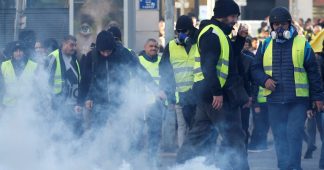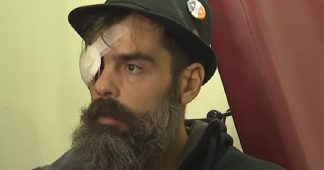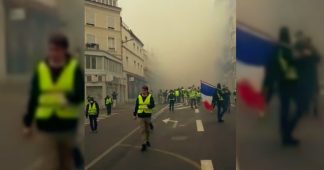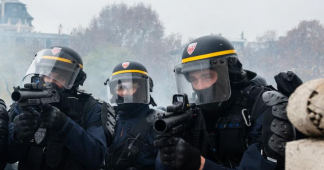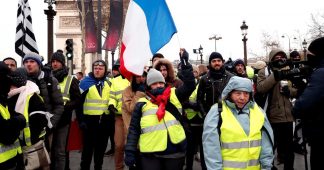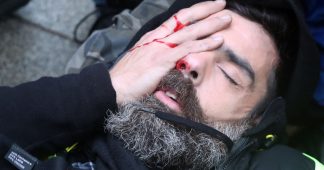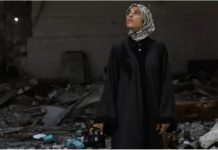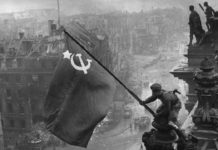By Pauline Bock
30 January 2019
A video of pacifist protester Jérôme Rodrigues being blinded in one eye has come to symbolise the state’s intolerance of dissent.
In the video that has stunned France, Paris’s Place de la Bastille is relatively calm, with gilets jaunes (yellow vests) protesters scattered around the square. Jérôme Rodrigues, a pacifist yellow vest figure, is filming 26 January’s “Act XI” on Facebook Live, greeting fellow yellow vests as his “family”, reminding them that they are “authorised” to be there (unlike previous ones, this march had been declared to the authorities) and regretting reports of violence elsewhere. At the nine-minute mark, police start closing in. An explosion goes off. Seconds later, Rodrigues falls to the ground, badly hurt in the eye as his friends call for help. The video has been watched more than 2.2 million times in less than a week.
Rodrigues, who may remain blind in one eye, is among dozens of protesters who have been severely injured by the French police since the start of the yellow vests movement last autumn. Unlike violence against the police, which has been sharply condemned by the government in several speeches — including president Emmanuel Macron’s new year’s address, in which he described protesters as a “hateful crowd” — police brutality against protesters went largely ignored by the authorities for months. Rodrigues’s footage, and his prominent standing within the movement, has shone a light on police violence and the horrific injuries their weapons have caused since the first protests in November.
In the UK, people attending a march mainly brace themselves for crowds and loud chanting. In France, protesters have made a habit of packing swimming goggles as protection against the tear gas the police will inevitably send their way (should their goggles not be confiscated first). Tear gas has long been used to disperse crowds by the French police, but its indiscriminate use against the yellow vests movement means protesters now risk losing a hand or an eye too.
Human rights groups have long warned of increasing levels of violence against French protesters. In December, Amnesty International called for the French police to “end the use of excessive force against protesters and high school children” after several cases of police injuring not only yellow vests, but also journalists, and even humiliating school pupils in a shocking viral video. “It is clear that the police have used excessive force against the mainly pacifist protesters, against journalists and even against minors,” concluded Rym Khadhraoui, a researcher on western Europe for Amnesty International.
The French authorities deploy weapons such as the Flash Ball (or LBD), a gun that fires high-speed rubber bullets. It is illegal to target someone’s head or genitals with such devices, but proof of repeated use by the French riot police has grown for months.
A census by the independent anti-police violence group Désarmons-les for the November-December period counted “one dead by tear-inducing grenade, four people losing a hand by a grenade, 18 blinded by LBD guns and grenades, one person who lost their hearing by a grenade”. By 12 January, the newspaper Libération’s own census had identified 82 severely injured protesters, of whom 60 had been hurt by a LBD gun. Seventy eight cases of injuries have been referred for investigation by the Paris prosecutor. In December, the freelance journalist David Dufresne started tweeting verified reports, often with graphic photos and video, of police brutality against protesters. He has posted more than 300 injuries so far and has since partnered with Médiapart to publish a detailed week-by-week census: like Libération, they counted one death from a grenade, four lost hands and 18 blinded eyes, as well as 160 head injuries. The vast majority of these injuries were caused by LBD guns. Dufresne denounces the “absolute omerta” around police violence.
He isn’t the only one. Libération has condemned a “state of denial”: “It is hard for the interior ministry to disregard this lacerated flesh, to ignore these broken faces and gouged out eyes caused by LBD bullets, to conceal the limbs that were snatched and riddled by the blow of TNT explosive grenades. Yet that is what is happening.”
Indeed, French interior minister Christophe Castaner has repeatedly denied that severe injuries have been caused by the police. “I know of no police officer who has attacked the yellow vests”, he said on 14 January. “On the other hand, I know officers who use defensive methods, to defend the public order and the Republic … Against extreme violence, you need defensive methods. There are people who come to provoke, to attack, even to kill.” On the eve of “Act XI”, the day Rodrigues was blinded, Castaner declared he was “staggered” by accusations of police brutality. “When I hear some people taking side with the hooligans rather than the police’s, when I hear mentions of incredible and illegitimate violence, I am staggered”, he said.
Laurent Nuñez, secretary of state to the interior minister, has insisted that “the police’s response is always proportionate.” Yet the imbalance in the French authorities’ response to police and protester violence is stunning. A yellow vest has been jailed for four months after he threw a can of rillettes at the police in Marseille, but no one has been sanctioned for the death of Zineb Romdhane, a 80-year-old Marseille local who died of injuries from a grenade thrown by the police into her home as she was closing her windows for protection. When Macron recently stated that none of the dead had been a victim of violence by the police, he seemingly forgot her.
But the government won’t be able to forget Rodrigues, who has vowed to file a complaint against Macron, Castaner and “the police officer who shot him”. His injury – filmed live, showing him engaging in no violence as he gets hurt – is being investigated by the IGPN, the “police of the police”. Rodrigues maintains he was shot by a LBD gun in the eye as a grenade exploded at his feet, wounding a friend. The police say no such LBD gun was used and that Rodrigues’ eye was blinded by a shard from the grenade.
Despite all police officers being equipped with body cams on that day, the footage from last Saturday has been declared unusable by the authorities for various reasons – batteries lasting only two hours before dying, hands and arms obstructing the lenses. There were two additional cameras filming from high up, but one filmed another police team while the other “did not film the right viewing angle”. However, footage from a protester, screened on TV, shows that an LDB gun was indeed fired.
“This is very serious, the government is shooting on its own people”, Rodrigues told me after he left the hospital on January 30. He is not yet sure whether his eye will partially recover or remain blind, but he knows that he wasn’t hurt by a grenade: the doctor’s report on his injury stipulates that an impact – and not a foreign object such as a grenade’s parts entering his eye – gouged it out.
Emphasising that he is merely one of hundreds injured, Rodrigues, who fears he won’t be able to work as a plumber again, hopes to continue fighting for the yellow vests’ demands: “ending tax on basic necessities products so that everyone can live on their salary, developing a new democratic system based on direct participation, equality before the law including for politicians.” Rodrigues, who describes himself as a humanist and pacifist, would also like the injured to receive public apologies from the French government. He sighed: “I’m the one losing my eye, but it’s the government who is blind.”
The French government has played on fear of “casseurs”, or thugs, to explain the use of dangerous weapons such as LBD. But Rodrigues isn’t one. After radical yellow vests promised “an unprecedented uprising” in response to his injury, Rodrigues called for peace from his hospital bed: “We are here to demand and to protest, and the message can only be heard if we’re at peace,” he said. “Don’t break anything, it would do a disservice to the cause.” To truly counter the French government’s violence, he concluded, the yellow vests must respond with peace.
Last year, during a presidential visit to Louvain university, a Belgian student asked Macron: “Why are you the only country that uses grenades against its own people?” (France is indeed the only European country that allows the armed forces to use TNT grenades against protesters.) At the time, Macron’s response was: “You’re speaking nonsense.” It might be time someone asks him again.
